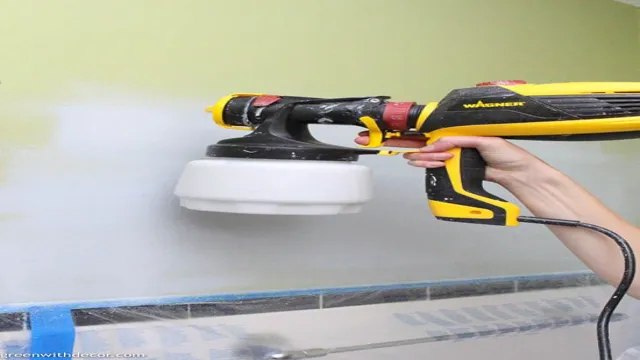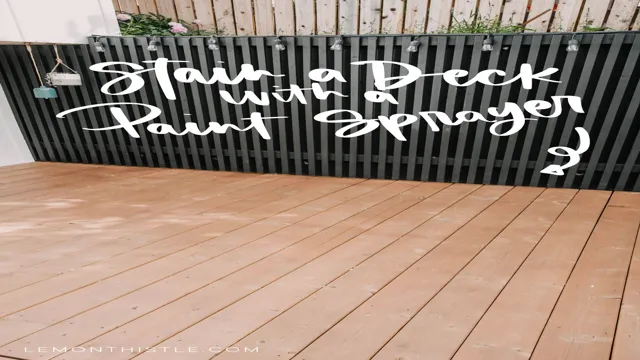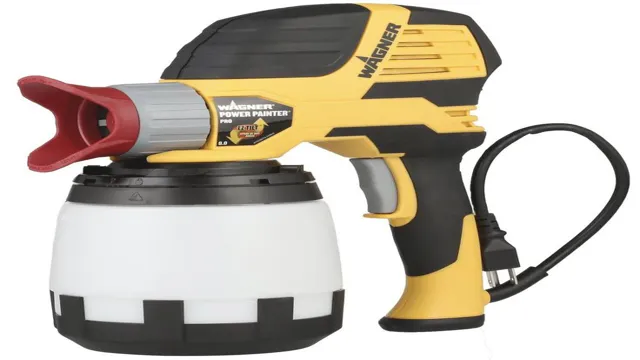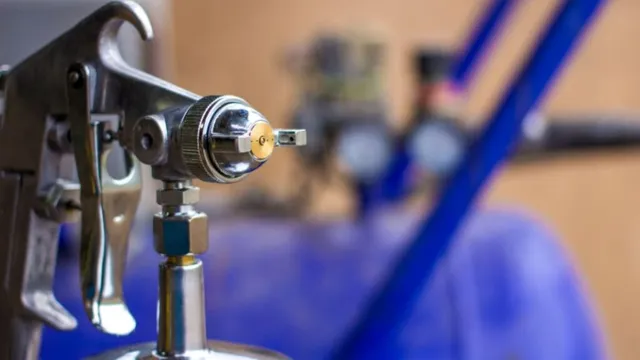Can You Use a Paint Sprayer for Texture? Tips and Tricks for Perfect Textured Walls.

Have you ever wanted to add a unique texture to your walls but weren’t sure how to achieve it? Using a paint sprayer for texture is a great option that can give your walls a new dimension and make them stand out. Instead of using traditional methods like rollers or brushes, a paint sprayer can create unique patterns and textures that will bring life to your walls. Not only is using a paint sprayer for texture effective, but it’s also efficient.
With a paint sprayer, you can cover large areas in a short amount of time, making it perfect for those who want to complete a DIY project quickly. The texture can be customized to your liking and can be adjusted to create different effects such as smooth, rough or even wood grain. Paint sprayers also produce a consistent finish, which means you won’t have to worry about any brush or roller marks ruining your design.
Plus, it’s easy to clean up and can be used on different surfaces like walls, ceilings, and furniture. Overall, using a paint sprayer for texture is a great option for those who want to add some personality and flair to their home. It’s efficient, effective, and easy to use, making it perfect for DIY enthusiasts and professionals alike.
So why not give it a try and see what kind of beautiful textures and patterns you can create?
What is Texture?
“Can you use a paint sprayer for texture?” is a common question among DIY enthusiasts. Texture refers to the appearance or feel of a surface and can be achieved by various methods such as using a trowel, roller, or spray gun. A paint sprayer, which is commonly used to apply a smooth and even coat of paint, can be used for texture as well.
However, it requires a specific type of sprayer and nozzle, and the texture material needs to be thinned adequately for it to work properly. Additionally, the pressure and distance of the sprayer from the surface play a vital role in achieving the desired texture. Therefore, before attempting to use a paint sprayer for texture, it is essential to research the correct equipment, materials, and techniques required for the project.
Explaining Texture
Texture refers to the physical feel of an object or surface. It is an essential characteristic of our sensation as humans and plays a significant role in how we perceive and understand our surroundings. Texture can be found virtually everywhere, from the rough surface of tree bark to the smoothness of glass.
Texture is perceived through touch and is a vital aspect of everyday experience. It can evoke emotions, mood, and even memories. By including texture into design, manufacturers can produce products with sensory appeal, improve their functionality, and create stimulating visual experiences.
Texture is a fundamental design element that can add depth, dimension, and interest to any composition. The incorporation of tactile qualities can make objects more visually appealing and enhance their overall value. Designers can use texture to create contrast and balance by adjusting its scale, direction, and intensity.
Texture is an essential aspect of art, design, and architecture, as it can significantly impact the viewer’s emotional response and add depth and visual interest to the composition. By understanding and utilizing texture effectively, designers can create more dynamic, engaging, and expressive works.

Using a Paint Sprayer for Texture
Can you use a paint sprayer for texture? The answer is yes! Using a paint sprayer for texture can save you a lot of time and effort, especially if you have a large surface area to cover. However, in order to achieve the desired texture, you will need to use a specific type of nozzle and adjust the spray pattern accordingly. You can choose from a variety of textures, including knockdown, orange peel, and popcorn texture.
It’s important to note that the type of texture you choose will determine the type of nozzle and spray pattern you will need. When using a paint sprayer for texture, it’s also important to properly prepare the surface by cleaning and sanding it to ensure that the texture will adhere properly. Overall, using a paint sprayer for texture can be a great option for those looking to save time and achieve a professional-looking finish.
Applying Texture with a Paint Sprayer
When it comes to adding texture to surfaces, a paint sprayer can be a useful tool. Using a paint sprayer allows you to achieve a variety of textures, including fine and coarse, with ease. Whether you’re looking to create an aged look on furniture or add dimension to a wall, a paint sprayer can help you achieve the desired texture in less time.
The key to using a paint sprayer for texture is in the nozzle choice. Many paint sprayers come with multiple nozzle options, and it’s important to choose the right one for the texture you’re trying to create. For example, a nozzle with a larger orifice will produce a coarser texture, while a smaller orifice will produce a finer texture.
Experimenting with the nozzle size and the paint consistency can help you achieve the desired texture for your project. With some practice, using a paint sprayer for texture can be an efficient and effective way to add dimension to your projects.
Texture Sprayer vs. Texture Gun
If you’re looking to add texture to your walls or ceilings, using a paint sprayer can be a great option. But, there are different types of texture sprayers to choose from, including texture guns. So, what’s the difference? A texture sprayer is designed specifically for adding texture to surfaces, while a texture gun is typically used for smaller jobs or touch-ups.
Texture sprayers are also usually more powerful and can handle larger projects. When using a texture sprayer for texture, it’s important to choose the right nozzle size and texture mix for the desired finish. It may take a bit of practice to get the hang of using a texture sprayer, but with some patience and experimentation, it can produce beautiful and unique results.
Types of Texture Sprayers
When it comes to adding texture to your walls or ceilings, a paint sprayer can be a lifesaver. There are a few different types of texture sprayers to choose from, each with its own benefits and drawbacks. One of the most popular types is the hopper gun, which feeds a mixture of drywall compound and water through a nozzle to create a stucco-like texture.
Another option is the airless sprayer, which uses high pressure to atomize the material so that it covers a large area evenly. When using a paint sprayer for texture, it’s important to choose the right nozzle size and texture mix, as well as to practice on a scrap surface before tackling the real thing. By doing so, you can achieve professional-looking results with ease.
Tips for Using a Paint Sprayer for Texture
Using a paint sprayer for texture can be a practical and efficient way to achieve your desired finish. The answer to the question “can you use a paint sprayer for texture?” is yes, you can. However, when using a paint sprayer for texture, there are a few tips to keep in mind to ensure the best results.
First, consider the type of texture you want to achieve and choose the proper tip size for your sprayer. A larger tip size will produce a more textured finish. Second, practice on a scrap piece of material to determine the right amount of pressure and distance needed to achieve the desired texture.
Finally, take your time and work in smaller sections to ensure even coverage and avoid streaks or drips. By following these tips, you can achieve a beautiful textured finish using a paint sprayer.
Choosing the Right Tip
Choosing the right tip is crucial when using a paint sprayer for texture. The size of the tip will determine the pattern and texture of your finish. A larger tip size will create a thicker and more pronounced texture while a smaller tip will result in a finer texture.
It’s important to consider the type of material you’re using as well, as thicker materials require larger tips. Additionally, be sure to test your sprayer before starting your project to ensure that you’re achieving the desired texture. By selecting the appropriate tip size and testing your equipment, you can successfully achieve the texture you want for your project.
Prepping Your Surface
Prepping Your Surface Before Using a Paint Sprayer for Texture When it comes to using a paint sprayer for texture, prepping your surface beforehand is key to achieving a flawless finish. First, you want to ensure that your surface is clean and free of debris. Any dust or dirt on the surface can cause unwanted bumps and imperfections in your texture.
Next, fill in any cracks or holes with spackle or joint compound, and sand down any rough patches. This will ensure that the texture is applied evenly and smoothly. It’s also important to choose the right texture nozzle for your sprayer and to test your texture on a spare piece of material before spraying it on your surface.
By taking the time to properly prep your surface, you’ll achieve professional-looking results with your paint sprayer every time.
Conclusion
In conclusion, using a paint sprayer for texture is like trying to play a grand piano with a sledgehammer. Sure, you can make some noise, but you won’t be creating any beautiful music. Just as a piano needs the finesse of a skilled pianist, texture requires the delicate touch of a specialized tool.
So, put down the sprayer and pick up a trowel, trust us, your walls (and ears) will thank you for it.”
FAQs
What is a paint sprayer used for?
A paint sprayer is used to apply paint quickly and efficiently to a surface.
Can you use a paint sprayer for texture?
Yes, you can use a paint sprayer to apply texture to a wall or surface. You would need to use a specialized nozzle or attachment designed for textured coatings.
How do you clean a paint sprayer after use?
To clean a paint sprayer after use, first empty any remaining paint from the container. Then fill the container with water or a cleaning solution and run the sprayer until the liquid runs clear through the nozzle. Finally, disassemble the sprayer and clean each part separately according to the manufacturer’s instructions.
What are the benefits of using a paint sprayer over a paint roller or brush?
Using a paint sprayer can save time and effort compared to using a roller or brush, as it can cover a larger surface area more quickly. It can also provide a more consistent finish and reach difficult-to-access areas more easily.
Can you use a paint sprayer to paint furniture?
Yes, you can use a paint sprayer to paint furniture. It can provide a smooth, even finish and can be quicker than using a brush.
Do you need to thin paint before using a paint sprayer?
It depends on the type of paint and the specific paint sprayer being used. Some paint sprayers require thinned paint, while others can handle thicker paints without issue. Check the manufacturer’s instructions for guidance on what type of paint to use and whether it needs to be thinned.
How do you choose the right paint sprayer for your project?
When choosing a paint sprayer, consider the type of project you will be working on, the type of paint you will be using, and your budget. Look for a sprayer that is compatible with the type of paint you will be using, has the right nozzle or attachment for your desired finish, and is within your budget. Reading reviews and getting recommendations from professionals or friends can also help in the selection process.



